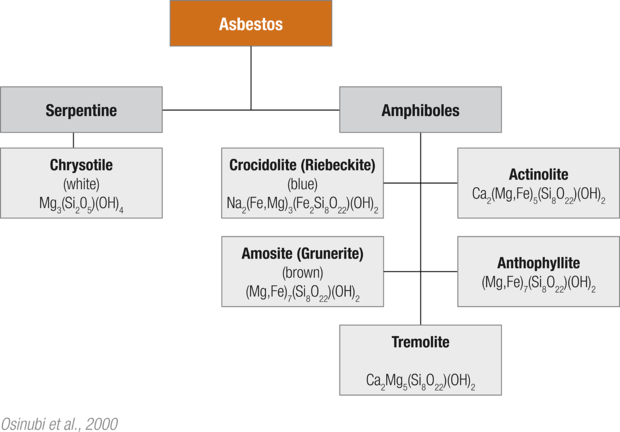On 31 March 2022, the Work Health and Safety (WHS) laws replaced the health and safety elements of the Mines Safety and Inspection laws. For information visit www.demirs.wa.gov.au/whs
All health and safety notifications, forms and guidance for mining and petroleum has moved to the WorkSafe website
What are fibrous minerals?

Naturally occurring minerals have many forms, and some have a fibrous form. While many types of mineral fibres inhaled at low concentrations have little effect on human health, others, depending on their fibrous habit and size, are decidedly harmful to the respiratory system. These are the asbestiform fibrous hydrated silicate minerals. Some occur naturally in both asbestiform and non-asbestiform forms, which have identical chemical compositions but different physical properties, morphology and health consequences.
Most fibrous minerals encountered in Western Australia are serpentine or amphibole asbestiform minerals such as chrysotile, crocidolite and actinolite, but other fibrous minerals may be encountered that can also damage the lungs.
Where are asbestiform minerals found in Western Australia?
Asbestiform minerals are widely distributed in Western Australia and can be major components of the mafic and ultramafic rocks hosting gold and base metal deposits located in Western Australia’s “greenstone belts”.
Amphibole minerals may also be encountered in the banded iron formations of the Hamersley Basin. Mining operations and exploration activities in these areas should assess if their workers are at risk.
When do fibrous minerals present a health risk?
Fibrous minerals only present a health hazard when airborne. For mining and exploration, this includes activities that generate dust such as drilling, sample cutting and collection, blasting, transporting material, and crushing.
The presence of older construction material on site that contains asbestos may also pose a risk.
Historically, exposure to asbestiform fibres over long periods of time has led to diseases such as asbestosis, lung cancer and mesothelioma. The concentrations of fibres encountered in the mining industry today are typically over a hundred times lower than experienced historically and are below current exposure standards.
How is the potential exposure to fibrous minerals managed?
If fibrous minerals exist on a mine site, a fibrous minerals management plan should be formulated, and made available to the Department of Mines, Industry Regulation and Safety upon request.
For new mine site approvals, this management plan should be included with the project management plan (PMP).
To maintain exposure to fibrous minerals at an acceptably low level, dust and fibres should be suppressed at source, with the ore mineralogy monitored to ensure fibrous mineral disturbance is minimal.
Exploration drilling is usually the first time that fibres are encountered. Dry drilling methods can produce large amounts of dust and fibres, particularly during reverse circulation or percussion drilling. Water or dust suppression systems are required, and flexible ducting should be used to direct dust away from workers, whether involved directly or working or based in the vicinity.
Mining operations are required to ensure all workers are appropriately informed and trained on the potential type and presence of fibrous minerals likely to be encountered. This training should also include the use and maintenance of personal protective equipment (PPE), required work practices, available engineering controls and other protective measures.
Audits and air monitoring, including measurement (counting) of airborne fibres, are an important part of determining the effectiveness of engineering and procedural controls, and assessing the potential exposure of workers.
Guidance material
Please refer to the following documents:
National asbestos ban
Asbestos has been used extensively throughout the construction industry in Western Australia, including on mine sites. Common examples are asbestos cement sheeting, and thermal and acoustic insulation.
A national ban on the use, sale or importation of asbestos took effect on 31 December 2003 and is reflected in the Mines Safety and Inspection Regulations 1995.
Information on asbestos in the workplace ban and its implications is available from WorkSafe.
The removal of asbestos containing material should only be carried out by a licensed asbestos removalist. Safe Work Australia has developed two model codes of practice for asbestos management and removal work.
The following model codes of practice are available from Safe Work Australia:
Related information
Please refer to the following links:
A list of National exposure standards is available from Safe Work Australia.
The UK-based Health and Safety Executive has a range of resources on asbestos health and safety.
